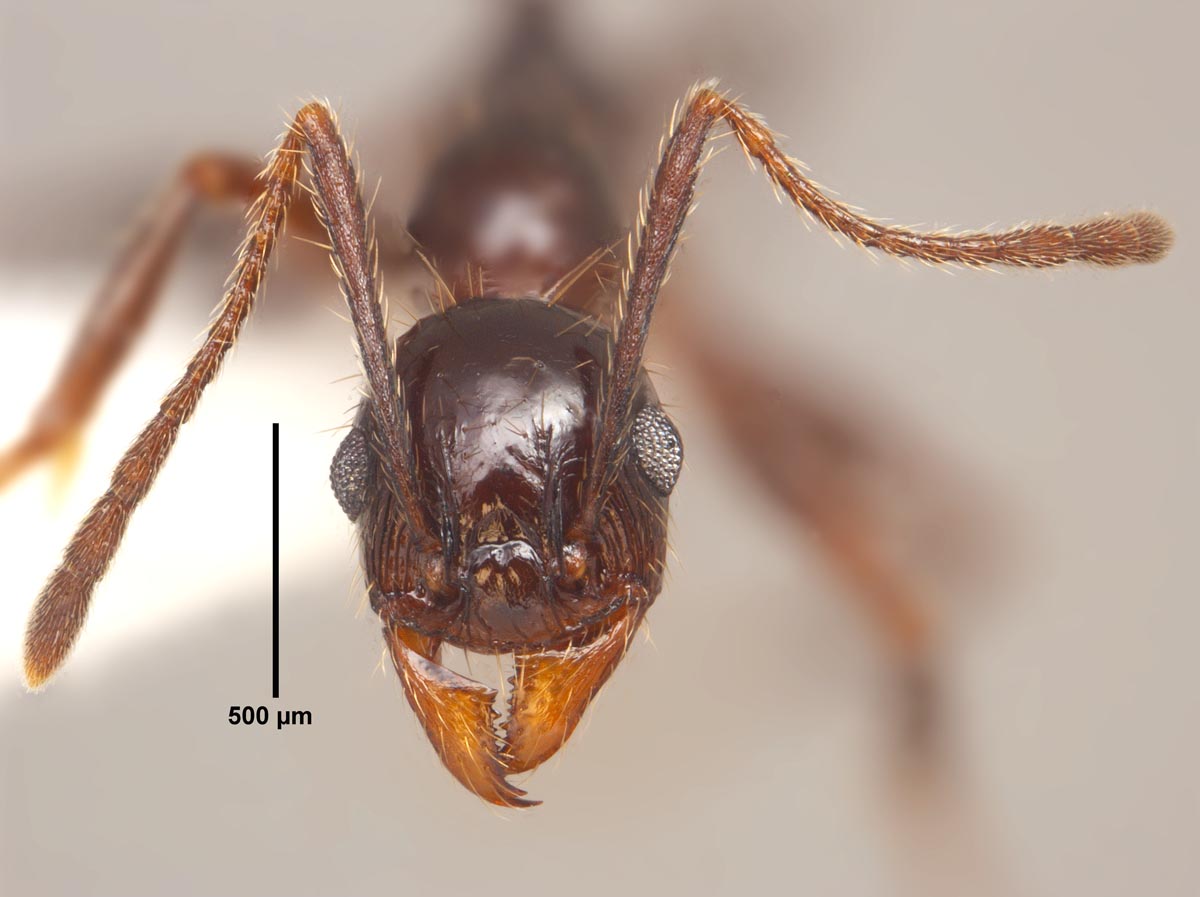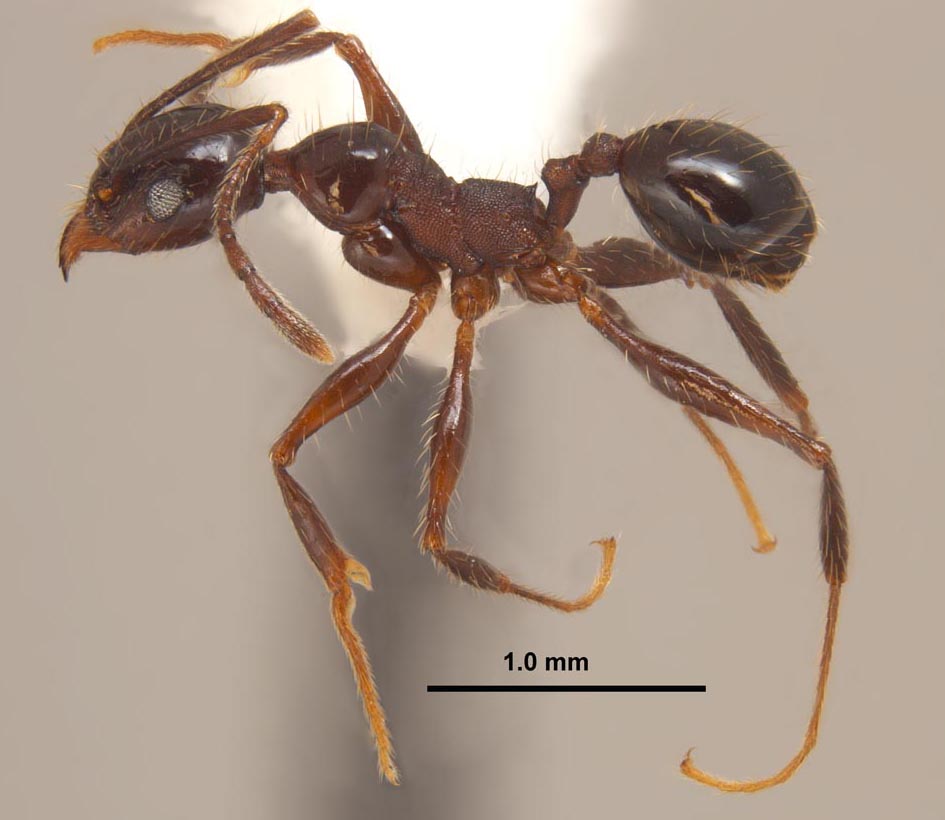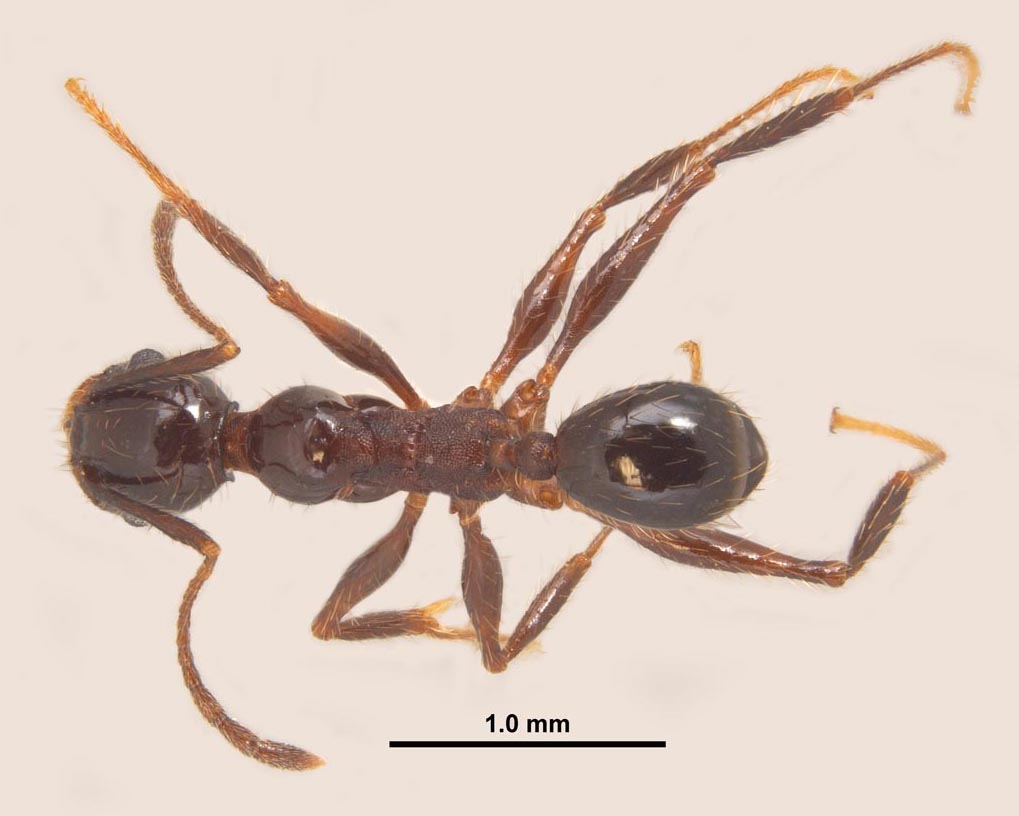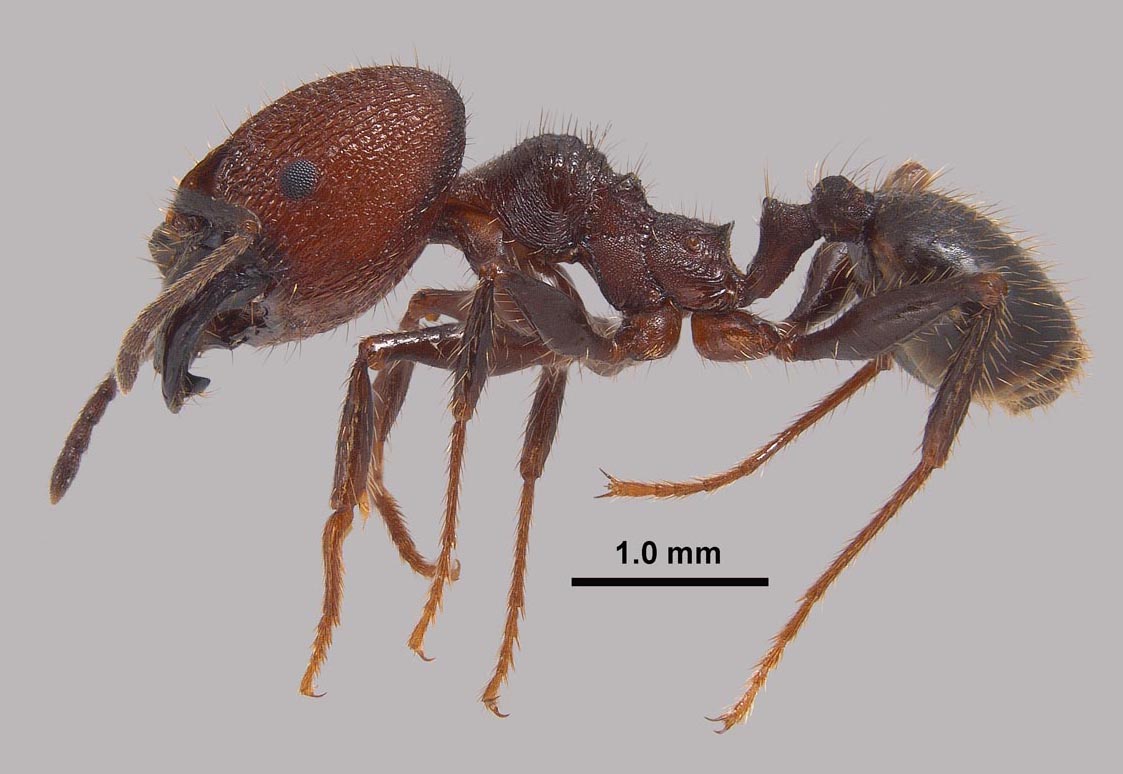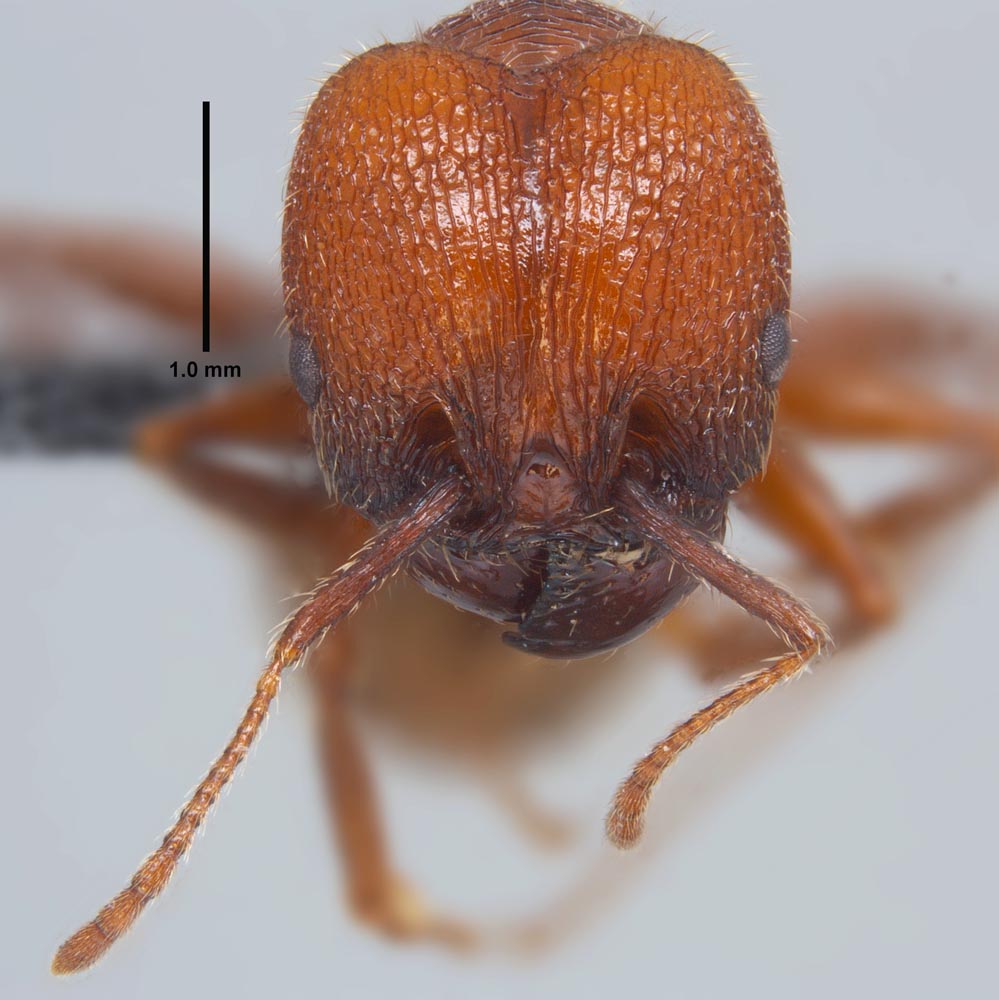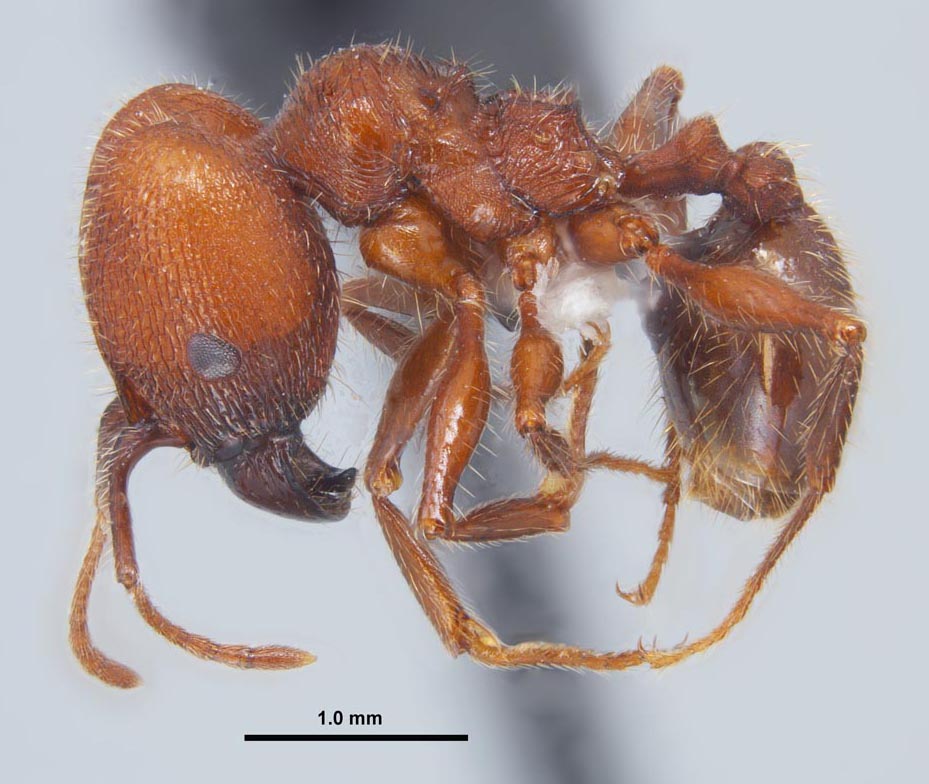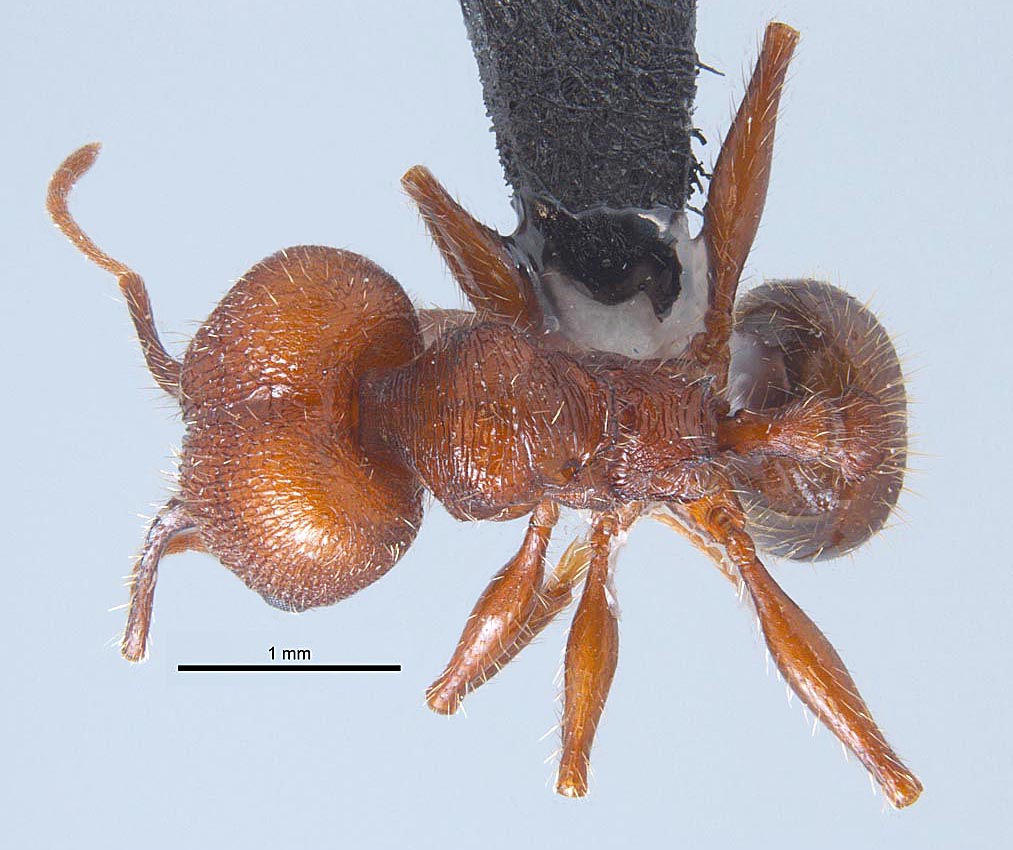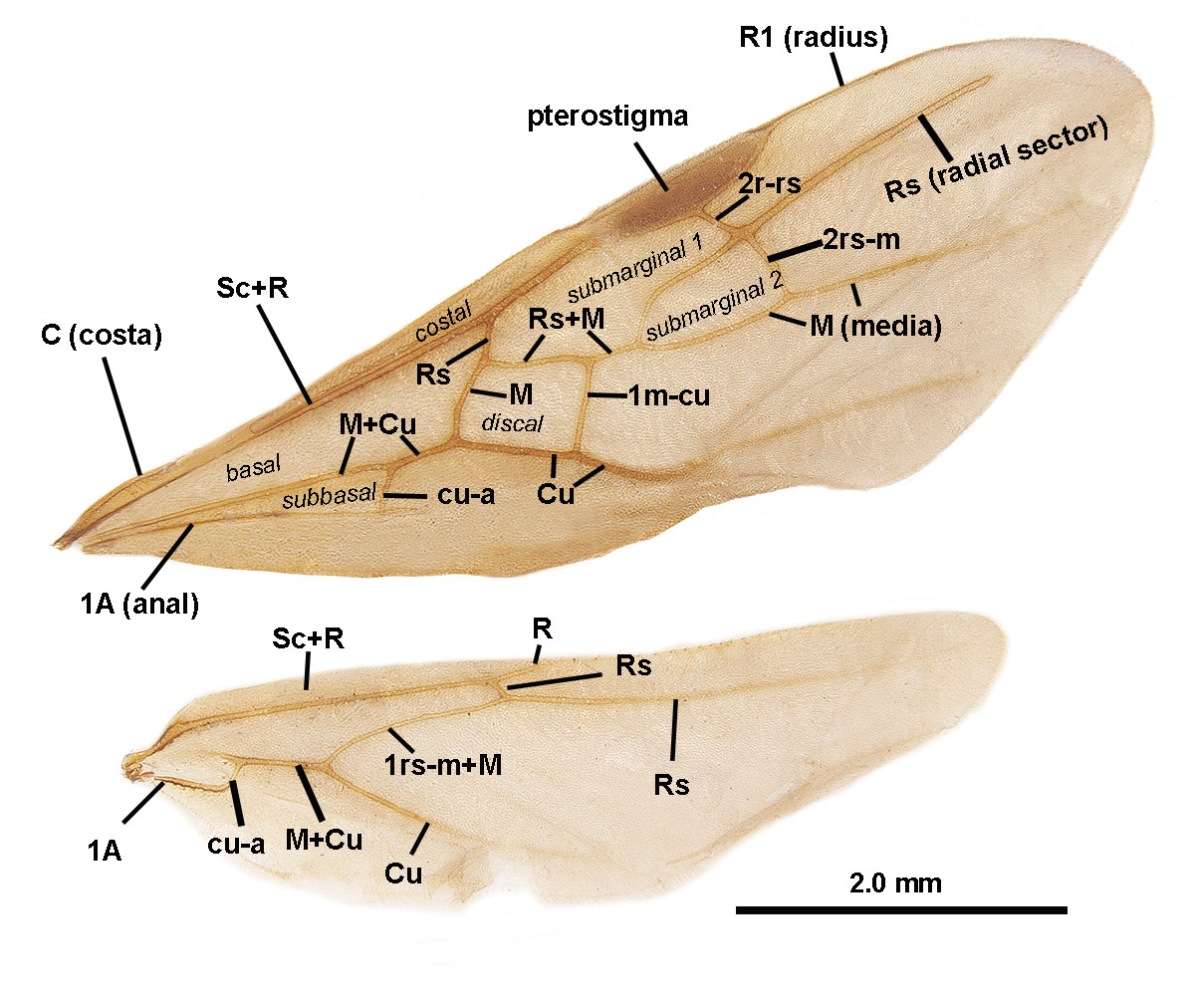Subfamily MYRMICINAE obscure big-headed ant Author: Joe A . MacGown |
||
Pheidole obscurithorax, full face view of a minor worker (Baldwin Co., AL) (photo by Joe A. MacGown) |
Pheidole obscurithorax, lateral view of a minor worker (Baldwin Co., AL) (photo by Joe A. MacGown) |
Pheidole obscurithorax, dorsal view of a minor worker (Baldwin Co., AL) (photo by Joe A. MacGown) |
Pheidole obscurithorax, full face view of a major worker (Baldwin Co., AL) (photo by Joe A. MacGown) |
Pheidole obscurithorax, lateral view of a major worker (Baldwin Co., AL) (photo by Joe A. MacGown) |
Pheidole obscurithorax, dorsal view of a major worker (Baldwin Co., AL) (photo by Joe A. MacGown) |
Pheidole obscurithorax, full face view of a major worker (Jackson Co., MS) (photo by Joe A. MacGown) |
Pheidole obscurithorax, lateral view of a major worker(Jackson Co., MS) (photo by Joe A. MacGown) |
Pheidole obscurithorax, dorsal view of a major worker (Jackson Co., MS) (photo by Joe A. MacGown) |
Pheidole obscurithorax, full face view of a dealate queen (Baldwin Co., AL) (photo by Joe A. MacGown) |
Pheidole obscurithorax, lateral view of a dealate queen (Baldwin Co., AL) (photo by Joe A. MacGown) |
Pheidole obscurithorax, dorsal view of a dealate queen (Baldwin Co., AL) (photo by Joe A. MacGown) |
Pheidole obscurithorax, forewing and hind wing of a queen with venation labeled. |
Pheidole obscurithorax, crater of colony |
|
Introduction Pheidole obscurithorax (Naves) (Formicinae), the obscure big-headed ant is a large, dark colored species native to South America that is now common along the US gulf coast from northern Florida to eastern Texas. Based on the steady expansion of its range in the US and its ability to successfully compete with the red imported fire ant (Solenopsis invicta Buren) and native species nesting in the same habitat, this species shows invasive potential in the US. Taxonomic History (from Bolton 2016) Diagnosis Identification Major Worker: Large, more than twice the size of minor workers (HL 1.62–1.84 mm, HW 1.56–1.72 mm, SL 0.92–1.00mm, EL 0.20–0.25mm, IHT 0.38–0.44mm, OHT 0.57–0.65mm, MeSL 1.47–1.62mm, PRW 0.86–0.96mm, PSL 0.08–0.12mm, PTW 0.24–0.32mm, PPW 0.34–0.47mm) (MEM specimens) (n=6). Head medium to dark reddish-brown, mandibles and antennal scapes dark reddish-brown to black: mesosoma, waist, and legs medium reddish brown to dark reddish brown; gaster dark reddish-brown to black; entire body with numerous flexuous, elongate setae present, setae on head shorter and stiffer. Head about as long as wide to slightly longer than wide; posterior corners strongly rounded; posterior margin deeply cleft; front and sides of head with strong rugoreticulation; anterior margin of clypeus with deep notch in middle; eyes small with numerous tiny facets; located on sides of head (in full face view) approximately one-third of head length from anterior edge of clypeus; antenna 12-segmented, apical three antenomeres forming a loose club; scape short, strongly angled basally and thickened mesally; mandibles large, mostly edentate, but with short, stout basal tooth, and two large apical teeth; hypostomal border with short, blunt tooth in middle, two short, triangular inner teeth (reduced in some specimens), and two widely spaced thickly triangular outer teeth. Mesosoma with "stepped" appearance in profile, promesonotal and metanotal sutures deep, pronotum raised above mesonotum, and mesonotum raised above propodeum; pronotum roughly rounded with transverse striae dorsally and semi-circular concentric striae laterally; mesopleurae and sides of propodeum mostly foveolate, but with some transverse striae, especially basally; mesonotal, metanotal, and propodeal dorsa with transverse striae, shiny; propodeal dorsum longer than declivity, short spines present. Waist two-segmented, with rough punctate sculpture; petiolar peduncle thickened, node conical in lateral view; postpetiole subquadrate in lateral view, ovate in dorsal view, wider that petiole. Gaster with strong shagreening on anterior half of first tergite; remainder of gaster mostly shining; sting absent. Queen: Large, larger than major worker (HL 1.36–1.42 mm, HW 1.58–1.64 mm, SL 0.98–1.00 mm, EL 0.32–0.40 mm, MeOL (median ocellar length) 0.15–0.16 mm, IHT 0.46–0.49 mm, OHT 0.63–0.65 mm, MeSL 2.53–2.55 mm, PRW 1.30–1.60 mm, PSL 0.12–0.15 mm PTW 0.53–0.55 mm, PPW 0.75–0.80 mm, WL 7.40–7.80 mm) (MEM specimens) (n=4). Concolorous dark reddish-brown; entire body with numerous semi-erect to erect setae present, with setae on head and dorsum of mesosoma shorter and stiff, those on gaster longer and more flexuous. Head quadrate, slightly wider than long; posterior border straight to weakly convex; front and sides of head with deep rugoreticulation present; anterior margin of clypeus with deep notch in middle; eyes large, placed at approximately the midpoint of head on sides of head in full face view; three ocelli present, arranged in roughly an equilateral triangle; Antenna 12-merous, apical three antenomeres forming a loose club; scape short, strongly angled basally and thickened mesally; mandibles large, mostly edentate, but with large basal tooth, four minute denticles, and two large apical teeth; hypostomal border with short, blunt tooth in middle, two short, triangular inner teeth, and two widely spaced thickly triangular outer teeth. Mesosoma enlarged for wings, dorsally flattened; dorsum of pronotum, mesonotum, and metanotum with longitudinal striae; sides of pronotum, mesopleurae, sides and dorsum of propodeum, and sides and dorsum of petiolar and postpetiolar nodes with transverse striae with punctation between striae dulling the surface; propodeal spines short, denticle-like. Wings, when present, with light yellow brown tint; pterostigma brown; forewing with closed costal, basal, subbasal,discal, and two submarginal cells; hingwing with costal, basal, and subbasal cells. Waist two-segmented, with rough punctate sculpture; petiolar peduncle thickened, node conical; postpetiole subquadrate in lateral view, oblong-ovate in dorsal view. First gastral tergite with fine striae anterior, becoming shagreened and finally shiny posteriorly. Biology and Economic Importance Pest Status Distribution Nearctic: United States (MEM and Wetterer et al. 2015). U.S. Distribution: AL, FL, GA, LA, MS, TX (MEM and Wetterer et al. 2015). Acknowledgments Literature Cited Bolton, B. 2016. Bolton World Catalog Ants. Available online: http://www.antweb.org/world.jsp. Accessed 9 February 2016. Calcaterra, L.A., Cuezzo, F., Cabrera, S.M., and Briano, J.A. 2010. Ground ant diversity (Hymenoptera: Formicidae) in the Iberá Nature Reserve, the largest wetland of Argentina. Ann. Entomol. Soc. Am. 103: 71-83. Calcaterra, L.A., Livore, J.P., Delgado, A., and Briano, J.A. 2008. Ecological dominance of the red imported fire ant, Solenopsis invicta, in its native range. Oecologia 156: 411–421. Hill, J.G. 2006. First report of the exotic ant, Pheidole obscurithorax Naves (Hymenoptera: Formicidae), attacking a hatchling chicken. J. Entomol. Sci. 41: 397-398. Naves, M. A. 1985. A monograph of the genus Pheidole in Florida, USA (Hymenoptera: Formicidae). Insecta Mundi 1:53-90. Santschi, F. 1923. Pheidole et quelques autres fourmis néotropiques. Annales de la Société Entomologique de Belgique 63:45-69. Storz, S.R. 2003. Distribution, spread, activity patterns, and foraging behaviors of the introduced ant Pheidole obscurithorax in the southeastern United States. M.S.Thesis, The Florida State University, Tallahassee; FL. Storz, S. R. and W. R. Tschinkel. 2004. Distribution, spread, and ecological associations of the introduced ant Pheidole obscurithorax in the southeastern United States. The Journal of Insect Science, 4: 12, 1-11. Wetterer, J., J. A. MacGown, and L. A. Calcaterra. 2015. Geographic spread of Pheidole obscurithorax(Hymenoptera: Formicidae). Transactions of the American Entomological Society 141: 222-231. Wilson, E. O. 2003. Pheidole in the New World. A dominant, hyperdiverse ant genus. Cambridge, Mass.: Harvard University Press, [ix] + 794 pp. Links |
||


